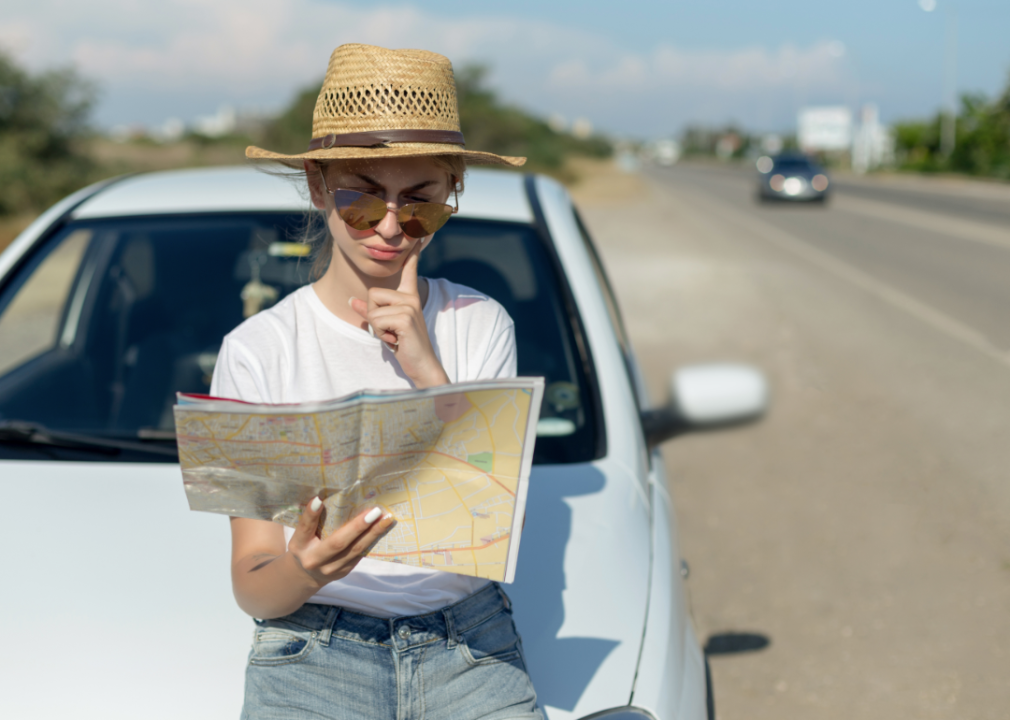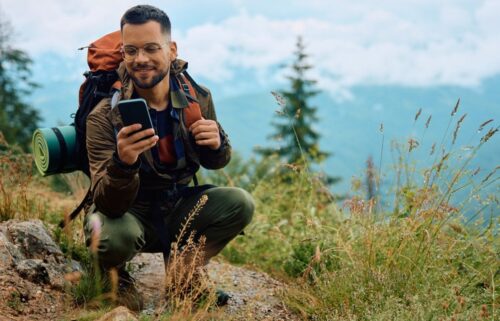How we traveled before GPS—and how the technology affects our brains

Canva
How we traveled before GPS—and how the technology affects our brains
A woman reads a roadmap by the side of the road.
If it feels like GPS has been around forever, that’s because it has. Well, at least the human brain-powered version. People have been making their way around the world—with and without maps—for ages. It is a true survival instinct. It has been just a few decades since humans outsourced their wayfinding to global navigation satellite systems.
The United States only completed its global positioning system in 1993. Perhaps because superpowers don’t want to rely on something outside their control, many other countries have their own version. Russia has GLONASS (1995), Europe has Galileo (2016), and China has BeiDou (2020).
The ubiquity of these tools makes it easy to do anything from find the nearest pizza parlor to drive cross-country, no matter where you are—as long as you pay enough attention that you avoid steering into bodies of water because of faulty directions (which has happened more than once) or traveling so far beyond your destination the road signs change languages.
That’s the problem with the technology: The mindless navigation it facilitates is a sign we are not using our brains to their fullest potential. Visible partnered with Stacker for a drive down memory lane to the days before GPS to explore how people once navigated their road trips. Now that GPS use has become commonplace, we also examined how the technology has changed our brains, according to scientific research.
Outsourcing navigation to GPS
The use of GPS supplants some of the functions of the hippocampus, an area of the brain in the temporal lobe that supports episodic and relational memory as well as spatial navigation, spatial memory, and mental mapping.
A study published in Nature in 2020 showed people who used GPS more in their lifetimes didn’t call on their hippocampus as much for navigation. Authors Louisa Dahmani and Véronique D. Bohbot studied 50 drivers from Montréal, questioning each about their lifetime GPS experience, GPS reliance, and sense of dependence on GPS in addition to their subjective sense of direction.
The scientists assessed the participants’ navigational abilities with two tests that featured landmarks such as mountain ranges, pyramids, and lakes. Subjects used two wayfinding strategies to get through the routes.
The first was a hippocampus-dependent spatial memory strategy that told people how their destination related to a landmark or feature in the background. A person finding their way might think, “Oh, the correct way is a bit to the right of the pyramids.”
The second technique was a stimulus-response strategy, where a person learned to move habitually because of stimuli, like knowing they had to turn left when they saw pyramids. This kind of wayfinding relies more on the caudate nucleus, a part of the brain that is also responsible for learning habits such as riding a bicycle. This type of learning, however, is a kind of autopilot and doesn’t allow for too much change. Adding a new landmark to a learned path may easily throw a traveler off their destination.
Three years later, 13 participants were retested.
“People with greater GPS habits may rely less on their hippocampus for navigation, as they exhibit a reduced use of spatial memory strategies, reduced cognitive mapping abilities, reduced landmark encoding, and as they have more difficulty learning navigational information,” according to the study.
Like muscles, the hippocampus must be exercised to maintain its form. Other studies bear this out, showing exploration and spatial navigation keep it fit.
Ancient maps of various practical uses
GPS and even paper map navigation don’t compare to how humans found their way for millennia. People first made maps as early as 16,500 BCE with stars and other landscape features etched on rocks and the walls of caves. It marked the next step in an evolutionary process that began with direct experience, using all our senses to make a mental map of the world around us rather than just our vision.
The Babylonian World Map, a roughly 15-square-inch clay tablet created circa 600 BCE, is the oldest known map of the Earth, but it was a symbolic representation. Ancient Greeks and Chinese didn’t craft the first paper maps until later.
These allocentric navigation tools—with information presented in relation to other landmarks in an environment—pushed the species forward; before maps, sailors used the sky to navigate, finding the sun, stars, and planets and staying within sight of the shoreline.
Still, maps were mostly symbolic objects and not quite precise representations. The first leap in making maps came in the second century with Claudius Ptolemy. An astronomer and astrologer, Ptolemy wanted to make more precise maps to produce better horoscopes, Matthew Edney, a professor of cartography at the University of Southern Maine, told Smithsonian Magazine.
By combining documents of town locations with travelers’ tales and devising a system of lines (what we now know as latitude and longitude), Ptolemy plotted around 10,000 places from Europe to Asia. He knew the world was round and found a way to represent it in two dimensions. Ptolemy’s realistic mapmaking, however, was lost for a time when the Roman Empire fell.
The next big breakthrough, which helped seafarers navigate far and wide, was achieved by Gerardus Mercator. His 1569 conformal cylindrical map projection distorted areas nearer the North and South poles by depicting the spherical Earth in two dimensions—but the use of latitudes and longitudes allowed for more accurate worldwide travel during the Age of Exploration.
The rise and price of GPS
A similarly indispensable advance came centuries later. During the Cold War, the United States Department of Defense first iterated GPS. Eleven satellites were launched from 1978 to 1985, and the system became fully operational with its 24th satellite in 1993.
It sparked inventions including MapQuest, which quickly succeeded navigational aids such as TripTiks—collections of maps that guided travelers to usable roads when they debuted in 1937 and later highlighted information about sightseeing, amusement parks, construction, heavy traffic, rest stops, and gas stations.
GPS-based gadgets and apps now navigate all but instantaneously, using trilateration—at least three satellites measure how far they are from a receiver—to pinpoint three-dimensional locations within 5 to 10 meters in a few seconds.
The technology is astounding, even today, in a world where smartphones outnumber people. In 2022, the devices were in the hands of two-thirds of the global population, meaning GPS is widely accessible.
The most crucial characteristic of GPS, arguably, is that it employs egocentric navigation—that is, from one’s point of view. You don’t need to know where you are; just that you’re turning right in one mile and right again after another four-tenths of a mile. Your destination will be on the left in 500 feet. Remembering how one landmark relates to another is unnecessary when following a robotic voice to your destination.
The simplicity has come with a cost. Apart from helping us make our way around the world, navigation has been said to be a starting point for memories. A popular mnemonic technique, for example, uses what’s called the “memory palace,” where one can recall information by journeying through a place they know well.
Separately, London cab drivers, who are required to pass the grueling “Knowledge of London” test and have outsized hippocampi that prove their mental understanding, have been recruited in research for Alzheimer’s.
The hippocampus is a critical part of our brain, and weakening it by no longer engaging in spatial navigation means we could also lose the memories that grow from those experiences—and part of who we are as humans.
Story editing by Carren Jao. Copy editing by Kristen Wegrzyn.
![]()




